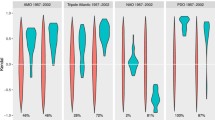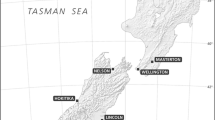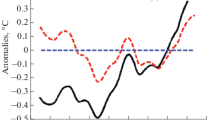Abstract
We use nine different observational datasets to estimate California-average temperature trends during the periods 1950–1999 and 1915–2000. Observed results are compared to trends from a suite of climate model simulations of natural internal climate variability. On the longer (86-year) timescale, increases in annual-mean surface temperature in all observational datasets are consistently distinguishable from climate noise. On the shorter (50-year) timescale, results are sensitive to the choice of observational dataset. For both timescales, the most robust results are large positive trends in mean and maximum daily temperatures in late winter/early spring, as well as increases in minimum daily temperatures from January to September. These trends are inconsistent with model-based estimates of natural internal climate variability, and thus require one or more external forcing agents to be explained. Observational datasets with adjustments for urbanization effects do not yield markedly different results from unadjusted data. Our findings suggest that the warming of Californian winters over the twentieth century is associated with human-induced changes in large-scale atmospheric circulation. We hypothesize that the lack of a detectable increase in summertime maximum temperature arises from a cooling associated with large-scale irrigation. This cooling may have, until now, counteracted summertime warming induced by increasing greenhouse gases effects.
Similar content being viewed by others
References
Bereket L, Fabris D, Gonzalez JE, Chiappari S, Zarantonello S, Miller NL, Bornstein R (2005) Urban heat islands in California’s Central Valley. Bull Am Meteorol Soc 86:1542–1543
Bonfils C, Duffy PB, Lobell DB (2006) Comment on ‘Methodology and results of calculating Central California surface temperature trends: evidence of a human-induced climate change?’. J Clim 20:4486–4489
Bonfils C, Fung I, Doney S, John J (2004) On the detection of summertime terrestrial photosynthetic variability from its atmospheric signature. Geophys Res Lett 31:L09207
Braganza K, Karoly DJ, Arblaster JM (2004) Diurnal temperature range as an index of global climate change during the twentieth century. Geophys Res Lett 31:L13217
Christy JR, Norris WB, Redmond K, Gallo KP (2006) Methodology and results of calculating Central California surface temperature trends: evidence of a human-induced climate change? J Clim 19:548–563
Dettinger MD, Cayan DR (1994) Large-scale atmospheric forcing of recent trends toward early snowmelt runoff in California. J Clim 8:606–623
Eischeid JK, Baker CB, Karl TR, Diaz HF (1995) The quality control of long-term climatological data using objective data analysis. J Appl Meteor 34:2787–2795
Gillett NP, Allan RJ, Ansell TJ (2005) Detection of external influence on sea level pressure with a multi-model ensemble. Geophys Res Lett 32:L19714
Hamlet AF, Lettenmaier DP (2005) Production of temporally consistent gridded precipitation and temperature fields for the continental U.S. J Hydrometeorology 6:330–336
Hegerl GC, Hasselmann K, Cubasch U, Mitchell JFB, Roeckner E, Voss R, Waszkewitz J (1997) Multi-fingerprint detection and attribution analysis of greenhouse gas, greenhouse gas-plus-aerosol and solar forced climate change. Clim Dyn 13:613–634
Jones PD, Moberg A (2003) Hemispheric and large-scale surface air temperature variations: An extensive revision and an update to 2001. J Clim 16:206–223
Karl TR, Jones PD, Knight RW, Kukla G, Plummer N, Razuvayev V, Gallo KP, Lindesay J, Charlson RJ, Peterson TC (1993) A new perspective on recent global warming—Asymmetric trends of daily maximum and minimum temperatures. Bull Amer Meteor Soc 74:1007–1023
Karl TR, Williams CN Jr, Quinlan FT (1990) U.S. Historical Climatology Network (HCN) Serial Temperature and Precipitation Data. ORNL/CDIAC-30, NDP-019/R1. Carbon Dioxide Information Analysis Center, Oak Ridge National Laboratory, U.S. Department of Energy, Oak Ridge, Tennessee
Karoly DJ, Braganza K (2005) A new approach to detection of anthropogenic temperature changes in the Australian region. Meteorol Atmos Phys 89:57–67
Karoly DJ, Wu Q (2005) Detection of regional surface temperature trends. J Clim 18:4337–4343
Karoly DJ, Braganza K, Stott PA, Arblaster JM, Meehl GA, Broccoli AJ, Dixon KW (2003) Detection of a human influence on North American climate. Science 302:1200–1203
Kueppers LM, Snyder MA, Sloan LC, Cayan D, Jin J, Kanamaru H, Kanamitsu M, Miller NL, Tyree M, Du H, Weare B (2007) Seasonal temperature responses to land-use change in the western United States. Glob Planet Change (in press)
Lobell D, Bala G, Duffy PB (2006) Biogeophysical impacts of cropland management on climate. Geophys Res Lett 33:L06708
Lynch P, Huang X-Y (1992) Initialization of the Hirlam model using a digital-filter. Mon Weath Rev 120:1019–1034
Maurer EP, Wood AW, Adam JC, Lettenmaier DP, Nijssen B (2002) A long-term hydrologically-based data set of land surface fluxes and states for the conterminous United States. J Clim 15:3237–3251
Mitchell JFB, Karoly DJ, Hegerl GC, Zwiers FW, Allen MR, Marengo J (2001) Detection of climate change and attribution of causes. In: Houghton JT et al. (eds) Climate Change 2001: The Scientific Basis, Contribution of Working Group I to the Third Assessment Report of the Intergovernmental Panel on Climate Change. Cambridge University Press, Cambridge, pp. 695–738
Mitchell TD, Carter TR, Jones PD, Hulme M, New M (2004) A comprehensive set of high-resolution grids of monthly climate for Europe and the globe: the observed record (1901–2000) and 16 scenarios (2001–2100). Tyndall Working Paper 55, Tyndall Centre, UEA, Norwich. UK. http://www.tyndall.ac.uk/
Mitchell TD, Jones PD (2005) An improved method of constructing a database of monthly climate observations and associated high-resolution grids. Int J Climatol 25:693–712
Santer BD, Taylor KE, Wigley TML, Johns TC, Jones PD, Karoly DJ, Mitchell JFB, Oort AH, Penner JE, Ramaswamy V, Schwarzkopf MD, Stouffer RJ, Tett S (1996) A search for human influences on the thermal structure of the atmosphere. Nature 382:39–46
Santer BD, Wigley TML, Boyle JS, Gaffen DJ, Hnilo JJ, Nychka D, Parker DE, Taylor KE (2000) Statistical significance of trends and trend differences in layer-average atmospheric temperature time series. J Geophys Res 105:7337–7356
Santer BD, Wigley TML, Gleckler PJ, Bonfils C, Wehner MF, AchutaRao K, Barnett TP, Boyle JS, Bruggemann W, Fiorino M, Gillett N, Hansen JE, Jones PD, Klein SA, Meehl GA, Raper SCB, Reynolds RW, Taylor KE, Washington WM (2006) Causes of ocean surface temperature changes in Atlantic and Pacific hurricane formation regions. Proc Natl Acad Sci U S A 103:13905–13910
Shindell DT, Schmidt GA, Miller RL, Rind D (2001) Northern Hemisphere winter climate response to greenhouse gas, ozone, solar, and volcanic forcing. J Geophys Res 106:7193–7210
Spagnoli B, Planton S, Deque M, Mestre O, Moisselin J-M (2002) Detecting climate change at a regional scale: the case of France. Geophys Res Lett 29:1450
Stott PA (2003) Attribution of regional-scale temperature changes to anthropogenic and natural causes. Geophys Res Lett 30:1728
Stott PA, Tett SFB (1998) Scale-Dependent Detection of Climate Change. J Clim 11:3282–3294
Stott PA, Tett SFB, Jones GS, Allen MR, Mitchell JFB, Jenkins GJ (2000) External control of 20th century temperature by natural and anthropogenic forcings. Science 290:2133–2137
Tett SFB, Stott PA, Allen MR, Ingram WJ, Mitchell JFB (1999) Causes of twentieth-century temperature change near the Earth's surface. Nature 399:569–572
Willmott CJ, Matsuura K (1998) Global air temperature and precipitation: regridded monthly and annual climatologies (version 2.01), Newark, Delaware: Center for Climatic Research. Dept. of Geography, Univ. of Delaware
Zwiers FW, Zhang X (2003) Towards regional climate change detection. J Clim 16:793–797
Author information
Authors and Affiliations
Corresponding author
Rights and permissions
About this article
Cite this article
Bonfils, C., Duffy, P.B., Santer, B.D. et al. Identification of external influences on temperatures in California. Climatic Change 87 (Suppl 1), 43–55 (2008). https://doi.org/10.1007/s10584-007-9374-9
Received:
Accepted:
Published:
Issue Date:
DOI: https://doi.org/10.1007/s10584-007-9374-9




